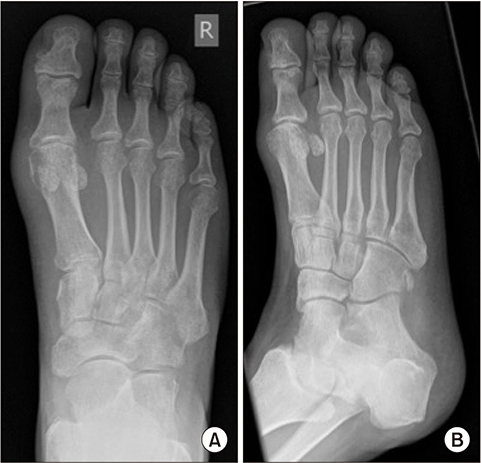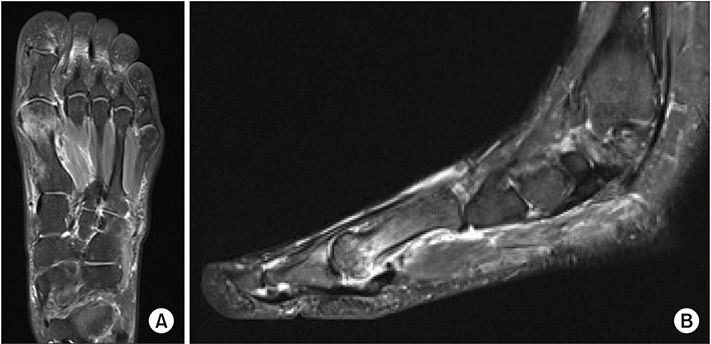J Korean Foot Ankle Soc.
2019 Jun;23(2):67-70. 10.14193/jkfas.2019.23.2.67.
Native 1st Metatarso-Phalangeal Joint Infection: A Rare Case Report
- Affiliations
-
- 1Department of Trauma and Orthopaedics, Brighton and Sussex University Hospitals NHS Trust, Brighton, United Kingdom. iliopoulose@gmail.com
- KMID: 2449674
- DOI: http://doi.org/10.14193/jkfas.2019.23.2.67
Abstract
- Septic arthritis is a serious medical condition that can lead to significant complications if misdiagnosed or mismanaged. A rare case of a 1st metatarso-phalangeal joint septic arthritis in a native joint is presented in a patient with no significant risk factors. A 41-year-old patient was referred by his general practitioner owing to ongoing pain and swelling over his native 1st metatarso-phalangeal joint with difficulty on weightbearing for three months. After a series of investigations, including blood tests and a foot magnetic resonance imaging, which were inconclusive, the patient was led to the operating theatre for sampling and washout of his joint. The samples taken in the theatres revealed septic arthritis with Streptococcus mitis as the causative microorganism. The patient was treated with six weeks of oral antibiotics with a good functional outcome. This case report illuminates this rare condition and makes foot and ankle surgeons aware of its existence. A high suspicion for this condition can prevent misdiagnosis and mismanagement.
Keyword
MeSH Terms
Figure
Reference
-
1. Nade S. Septic arthritis. Best Pract Res Clin Rheumatol. 2003; 17:183–200. DOI: 10.1016/S1521-6942(02)00106-7.
Article2. McClatchey WM, Goldman JA. Pseudopodagra from hemophilus influenza in an adult. Arthritis Rheum. 1979; 22:681–683. DOI: 10.1002/art.1780220607.3. Riera E, Mateo L, Sallés M, Pérez R. [Septic pseudopodagra by Streptococcus agalactiae]. Reumatol Clin. 2006; 2:324–326. Spanish. DOI: 10.1016/S1699-258X(06)73069-8.4. Wynes J, Harris W 4th, Hadfield RA, Malay DS. Subtalar joint septic arthritis in a patient with hypogammaglobulinemia. J Foot Ankle Surg. 2013; 52:242–248. DOI: 10.1053/j.jfas.2012.10.012.
Article5. Kaandorp CJ, Dinant HJ, van de Laar MA, Moens HJ, Prins AP, Dijkmans BA. Incidence and sources of native and prosthetic joint infection: a community based prospective survey. Ann Rheum Dis. 1997; 56:470–475. DOI: 10.1136/ard.56.8.470.
Article6. Pavic K, Pandya J, Sebak S, Shetty A, Spencer D, Manolios N. Acute arthritis: predictive factors and current practice in the approach to diagnosis and management across two hospitals in Sydney. Intern Med J. 2018; 48:1087–1095. DOI: 10.1111/imj.13969.
Article7. Young JL, May MM, Haddad SL. Infected total ankle arthroplasty following routine dental procedure. Foot Ankle Int. 2009; 30:252–257. DOI: 10.3113/FAI.2009.0252.
Article8. Yusuf E, Hofer M, Steinrücken J, Trampuz A, Borens O. Septic arthritis of the pubic symphysis caused by streptococcus mitis. Acta Clin Belg. 2014; 69:454–455. DOI: 10.1179/2295333714Y.0000000059.9. Seng P, Vernier M, Gay A, Pinelli PO, Legré R, Stein A. Clinical features and outcome of bone and joint infections with streptococcal involvement: 5-year experience of interregional reference centres in the south of France. New Microbes New Infect. 2016; 12:8–17. DOI: 10.1016/j.nmni.2016.03.009.
Article10. Rapeport KB, Girón JA, Rosner F. Streptococcus mitis endocarditis. Report of 17 cases. Arch Intern Med. 1986; 146:2361–2363. DOI: 10.1001/archinte.1986.00360240083014.
Article
- Full Text Links
- Actions
-
Cited
- CITED
-
- Close
- Share
- Similar articles
-
- Irreducible Dorsal Dislocation of First Metatarsophalangeal Joint by Closed Method: Report of a Case
- Surgical Treatment of Chronic Tophaceous Gout in the 1st Metatarso-Phalangeal Joint
- Snapping Metacarpo-Phalangeal Joint after Depressed Fracture of Metacarpal Neck: Case Report
- The Tricho-Rhion-Phalangeal Syndrome (A Case Report)
- Reconstruction of Rheumatoid Forefoot Deformities



